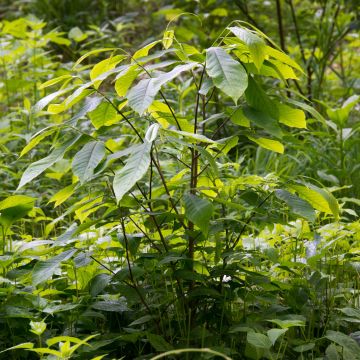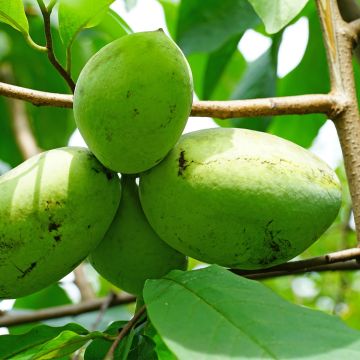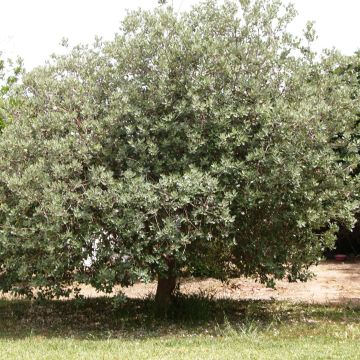

Asimina Sunflower - Pawpaw


Asimina Sunflower - Pawpaw
Asimina Sunflower - Pawpaw
Asimina triloba Sunflower
Pawpaw, Paw Paw, Paw-Paw, Common Pawpaw, Indiana Banana, American Custard Apple
Why not try an alternative variety in stock?
View all →This plant carries a 6 months recovery warranty
More information
We guarantee the quality of our plants for a full growing cycle, and will replace at our expense any plant that fails to recover under normal climatic and planting conditions.
From €7.90 for pickup delivery and €6.90 for home delivery
Express home delivery from €8.90.
From €7.90 for pickup delivery and €6.90 for home delivery
Express home delivery from €8.90.
Description
Asimina Sunflower is a variety that produces large fruits with pale yellow skin and flesh, with few seeds, and very tasty. The texture and taste of asiminas are a cross between mango and banana. This variety, originally from America, is self-fertile: a single tree is enough to produce fruit, although fruiting will be more abundant in the presence of multiple asimina trees. The Asimina tree is a rare small tree that takes time to establish but is very hardy.
Asimina triloba or Paw Paw is a small tree with tropical appearances while being perfectly adapted to temperate climates, enjoying fairly warm summers and cold winters. Fruit production begins when the plant reaches 2 to 2.50 m (7 to 8ft), which is around 3 to 6 years. These fruits, appearing alone or in clusters on the branches, are edible.
Asiminas are large oval berries that can measure up to 15 cm (6in). The skin is green-yellow in colour when ripe and contains a creamy pulp, usually yellow, dotted with large black seeds. The taste and texture of asimina are reminiscent of both mango and banana. The fruits are harvested when they become soft to the touch and ready to fall. The harvest lasts about twenty days, around the month of September. Once harvested, the fruits can be stored for a few days at room temperature or one to two weeks in the refrigerator. Peel the fruits and remove the seeds before consuming. You can eat them fresh or make ice cream, sorbets, juices, or compotes. Asimina is rich in vitamins A and C, as well as amino acids and trace elements.
Little known, the trilobed Asimina tree is a shrub native to the United States and Canada and belongs to the Annonaceae family. The floral buds, round in shape, appear in the axils of the leaves in summer and will open in the following spring, around the month of April, just before the new leaves appear. These are bell-shaped flowers, 5 cm (2in) in diameter, with 6 purple petals. They appear alone or in small clusters on the branches. This variety has the characteristic of being self-fertile. A single tree is enough to produce fruit, although fruiting will be more abundant in the presence of other asimina trees.
The Asimina tree has a pyramidal habit and can be trained in a goblet shape to facilitate harvesting. When fully grown, it can reach a height of 5 to 10 m (16 to 33ft) with a width of about 3 to 5 m (10 to 16ft). In the garden, with regular pruning, this tree can grow to a height of 3 m (10ft) with a width of 2 to 2.50 m (7 to 8ft). Its growth is slow, especially during the first few years as the Asimina tree develops its root system. This small deciduous tree is very hardy and can withstand temperatures as low as -25°C (-13°F). Its leaves are alternate, rather trailing, and elongated oval in shape. They are green in summer, turn a beautiful yellow colour in autumn, and then brown and fall off.
Asimina Sunflower - Pawpaw in pictures




Plant habit
Fruit
Flowering
Foliage
Botanical data
Asimina
triloba
Sunflower
Annoncaeae
Pawpaw, Paw Paw, Paw-Paw, Common Pawpaw, Indiana Banana, American Custard Apple
North America
Other Asimina trees
Planting and care
The Pawpaw tree likes deep, moderately rich, well-drained soils with a neutral or slightly acidic pH. Plant it in full sun or, if your summers are very hot, in partial shade. Planting is preferably done in February-March, before the start of vegetation, or in autumn.
Loosen the soil deeply as the Pawpaw tree will develop a long taproot. Space the young plants 2.50 to 3 m (8 to 10ft) apart. Dig a wide planting hole (at least 3 times the size of the root ball). Mix compost into the soil and then place the young plant without touching the delicate roots. Fill the hole, tamp it down well, and water thoroughly.
No treatment is necessary as the Pawpaw tree is not very susceptible to diseases or insects. Its leaves even have an insecticidal effect.
Planting period
Intended location
Care
-
, onOrder confirmed
Reply from on Promesse de fleurs
Unusual and exotic fruit trees
Haven't found what you were looking for?
Hardiness is the lowest winter temperature a plant can endure without suffering serious damage or even dying. However, hardiness is affected by location (a sheltered area, such as a patio), protection (winter cover) and soil type (hardiness is improved by well-drained soil).

Photo Sharing Terms & Conditions
In order to encourage gardeners to interact and share their experiences, Promesse de fleurs offers various media enabling content to be uploaded onto its Site - in particular via the ‘Photo sharing’ module.
The User agrees to refrain from:
- Posting any content that is illegal, prejudicial, insulting, racist, inciteful to hatred, revisionist, contrary to public decency, that infringes on privacy or on the privacy rights of third parties, in particular the publicity rights of persons and goods, intellectual property rights, or the right to privacy.
- Submitting content on behalf of a third party;
- Impersonate the identity of a third party and/or publish any personal information about a third party;
In general, the User undertakes to refrain from any unethical behaviour.
All Content (in particular text, comments, files, images, photos, videos, creative works, etc.), which may be subject to property or intellectual property rights, image or other private rights, shall remain the property of the User, subject to the limited rights granted by the terms of the licence granted by Promesse de fleurs as stated below. Users are at liberty to publish or not to publish such Content on the Site, notably via the ‘Photo Sharing’ facility, and accept that this Content shall be made public and freely accessible, notably on the Internet.
Users further acknowledge, undertake to have ,and guarantee that they hold all necessary rights and permissions to publish such material on the Site, in particular with regard to the legislation in force pertaining to any privacy, property, intellectual property, image, or contractual rights, or rights of any other nature. By publishing such Content on the Site, Users acknowledge accepting full liability as publishers of the Content within the meaning of the law, and grant Promesse de fleurs, free of charge, an inclusive, worldwide licence for the said Content for the entire duration of its publication, including all reproduction, representation, up/downloading, displaying, performing, transmission, and storage rights.
Users also grant permission for their name to be linked to the Content and accept that this link may not always be made available.
By engaging in posting material, Users consent to their Content becoming automatically accessible on the Internet, in particular on other sites and/or blogs and/or web pages of the Promesse de fleurs site, including in particular social pages and the Promesse de fleurs catalogue.
Users may secure the removal of entrusted content free of charge by issuing a simple request via our contact form.
















































